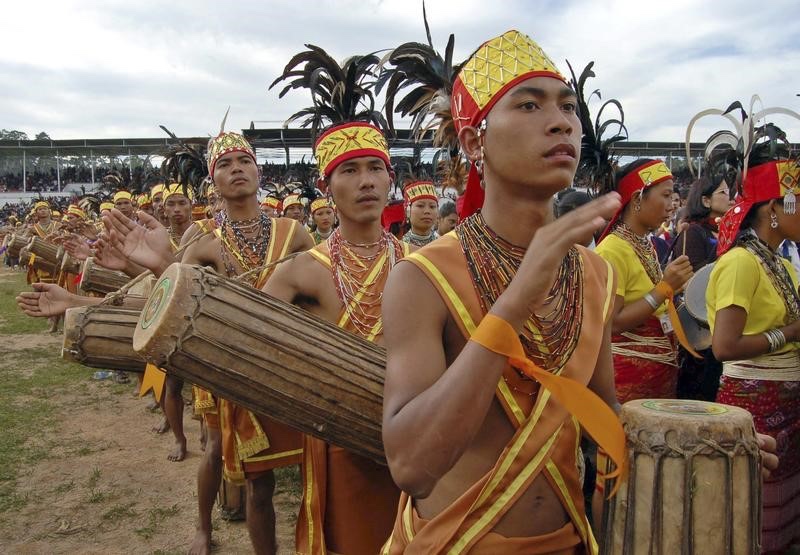Shillong, India,
Thomson Reuters Foundation
Customary laws in the north-eastern states of India are failing to protect Indigenous lands and must be reformed to safeguard the property of women and poorer tribal people, land rights analysts said on Tuesday.
Customs related to Indigenous tradition, including those on land use, are protected by the Indian constitution in four of the seven north-eastern states, where land is owned and managed by tribal communities and clans without formal titles.

A group of Garo tribal men beat drums to establish a new world record of drum assembles at Shillong, the capital of India’s north-0eastern state of Meghalaya, on 28th October, 2006. PICTURE: Reuters/Utpal Baruah
But some states have recently introduced laws to promote individual ownership of land and give governments greater power, thereby weakening customary laws and protections, according to Walter Fernandes, a senior fellow at the North Eastern Social Research Centre, an Indian thinktank.
While customary laws prevents the sale or transfer of tribal land to non-tribals, there is no ban on the state acquiring such land, he added at the sidelines of a conference in Shillong in the north-eastern state of Meghalaya.
Power also rests with tribal elites, who are usually men and can pressure women and poorer members to consent to commercial projects, or sell their land, Fernandes said.
“Customary law needs to be reformed, as it does not adequately protect the rights of women or community members from powerful members of their own community,” he said.
“Without adequate protection, the formalisation of land tenure – rather than the gradual evolution of the informal – has led to conflict and alienation of Indigenous land,” he said.
The north-eastern states are among the most heavily forested and resource-rich land in India, yet these rural areas have greater landlessness than the national average.
Last year, the Supreme Court ruled that Indigenous people in Meghalaya – which has constitutional protections – have full rights over the land and its resources, and that only they can grant permission for mining.
Yet Arunachal Pradesh state in 2018 passed a law that granted individual ownership of land for the first time. Authorities said it would give enable tribal communities to use land as collateral for loans, and earn higher incomes.
As land comes under increasing pressure for highways, dams, mines and factories, a maze of hundreds of federal, state and customary laws are sparking conflicts over land, according to the Centre for Policy Research, a thinktank in Delhi.
Tribal people are the worst affected: they make up less than 10 per cent of India’s 1.3 billion population, but account for 40 per cent of people who were uprooted from 1951 to 1990 due to dams, mines, industrial development and wildlife parks, according to the CPR.
Better protections are needed for customary laws, with potential measures such as a cap on land ownership in tribal areas, and a ban on sale of all common lands, Fernandes said.
But while strengthening customary laws would give additional power to tribal communities, “there is always a risk that this power is concentrated in the hands of only the tribal chieftainship,” said Kanchi Kohli, a senior researcher at CPR.
“Legally, strengthening of customary laws may not ensure protection of land rights or commons. Any recognition of customary laws should come with internal checks and external balances,” she told the Thomson Reuters Foundation.





